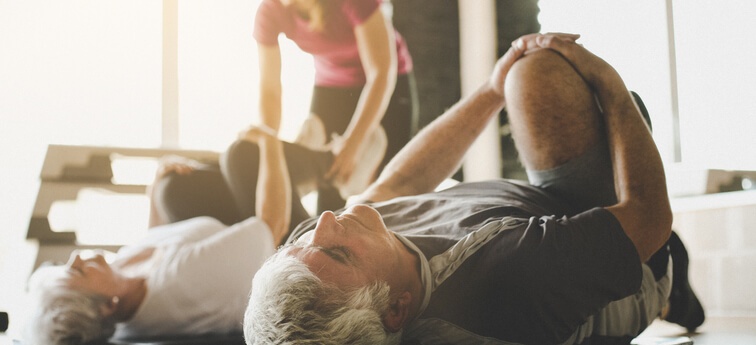
What You'll Learn

You’re never too old to be physically fit. Age accelerates the loss of muscle and bone mass. This can lead to weakness, play a role in osteoporosis and increase the risk of falls. Exercise can reduce this risk. Seniors who remain physically active may live longer, maintain a more independent lifestyle, have less physical pain due to joint health issues and arthritis, have a lower risk of dementia and have better mental health.
Exercise is so important to well-being that the Center for Disease Control and Prevention’s (CDC) physical activity guidelines don’t change based on age. The CDC recommends at least 150 minutes of moderate-intensity aerobic activity such as walking, or 75 minutes of intense aerobic activity, per week. Seniors should also do muscle-strengthening activities at least twice per week. For seniors, 300 minutes of moderate-intensity aerobic activity offers even greater health benefits. Exercise doesn’t have to be strenuous or painful to be helpful. Even 5 minutes of exercise several times a day can improve your health.
Here are the top 10 exercises for seniors in retirement.
Walking
Walking requires no special skill and is safe even for seniors with mobility impairments or degenerative conditions. Try finding a local park you love and scheduling a walking date with a grandchild or friend. To get even more out of your walking routine, check out these walking exercises for seniors.
Gardening
If you love tending a garden, turn it into a mobility-friendly workout. Instead of bending and stooping to dig up weeds, try squatting and keeping your back straight. If you find that chronic pain makes gardening difficult or that you’re often hunched over while gardening, try these exercises to strengthen your body for pain-free gardening.
Playing With Pets or Grandchildren
Exercise doesn’t have to feel like exercise. Anything that gets you moving counts. So rather than sitting quietly and talking to your grandkids or stroking your dog, get moving. Try playing on the floor with a grandchild, playing tug with a beloved dog or simply chasing a grandchild or pet around the yard. This low-intensity exercise keeps your muscles limber and your body healthy.
Swimming
For seniors who want vigorous exercise but have joint health issues or mobility impairments, swimming is a great option. Strong swimmers may love swimming laps. People who prefer a less intense workout or who aren’t comfortable in water may enjoy water aerobics classes. Many senior centers and gyms offer water aerobics classes especially for seniors. Seniors can also try a few simple water aerobics exercises on their own.
Yoga
Yoga offers a nearly infinite range of possibilities. Beginners can get an excellent back stretch with simple postures like child’s pose. Yoga devotees can commit years to their yoga practice, building up to challenging balance and stretching postures. Seniors can even do yoga from a chair. Consider looking into a local yoga class or senior chair yoga at your local senior center.
Balance Exercises
As you age, balance becomes more difficult. It also becomes more critical to your health. Simple balance exercises can strengthen your body, support mobility and reduce your fall risk. Try standing on one foot and then the other, supported with a sturdy piece of furniture if necessary. See more balance exercises here.
Dancing
Dancing offers a great cardiovascular workout, as well as a chance to build strength and connect with your dance partner. Try a senior dance class at your local gym or senior center. Or crank up the music, and dance in the privacy of your own home.
Calisthenics
Calisthenics are repeated movements that can strengthen various muscle groups, reducing the risk of a fall and supporting healthy muscle and bones. Try lying on your back and lifting your legs to pedal, as if you’re riding a bike. Next, lift your hips off the ground with your knees bent and feet flat on the ground. Adjust the number you do based on how your body feels. Then gradually build up to a 15-minute low-impact calisthenic workout. The goal should be to work hard, but not to feel pain or complete exhaustion.
Aerobics Classes
Aerobic exercise is great for your heart. Seniors may be reluctant to get their heart rate up, though, especially if they have heart health issues. Senior aerobics classes offer a safe way to burn calories and protect your heart. To find classes appropriate for your level of fitness, contact your local senior center or gym. At home, try briskly walking in place or alternating leg lifts. View more senior aerobics ideas.
Wheelchair Exercises
Decreased mobility due to age or degenerative conditions such as Parkinson’s confines some seniors to wheelchairs. This doesn’t have to mean an end to physical activity. In fact, remaining physically active can reduce pain and improve health in wheelchair users. Consider an exercise class for people in wheelchairs. Seniors who are more adventurous may even consider a wheelchair sport, such as wheelchair-racing or basketball. Those who prefer to avoid classes can do simple wheelchair stretches such as touching the toes or extending and rotating the shoulders.
Want to learn more about remaining active and healthy no matter your age? Check out The Busy Person’s Guide to Recreation in Retirement. In this guide, we look at the countless health benefits of staying active and provide some fun, low-impact activities and exercises that will make it easy to maintain a healthy lifestyle without taking up too much time.


